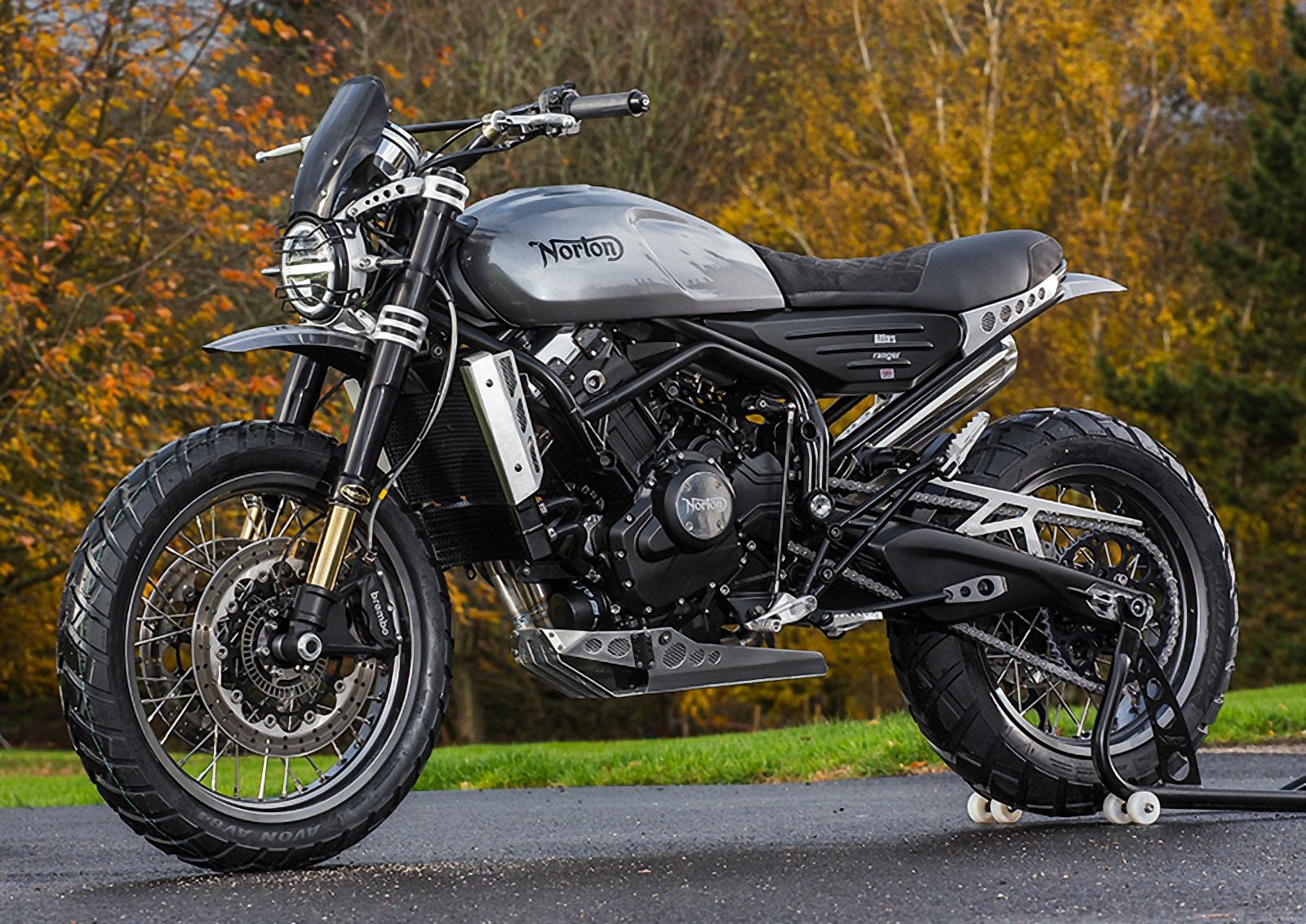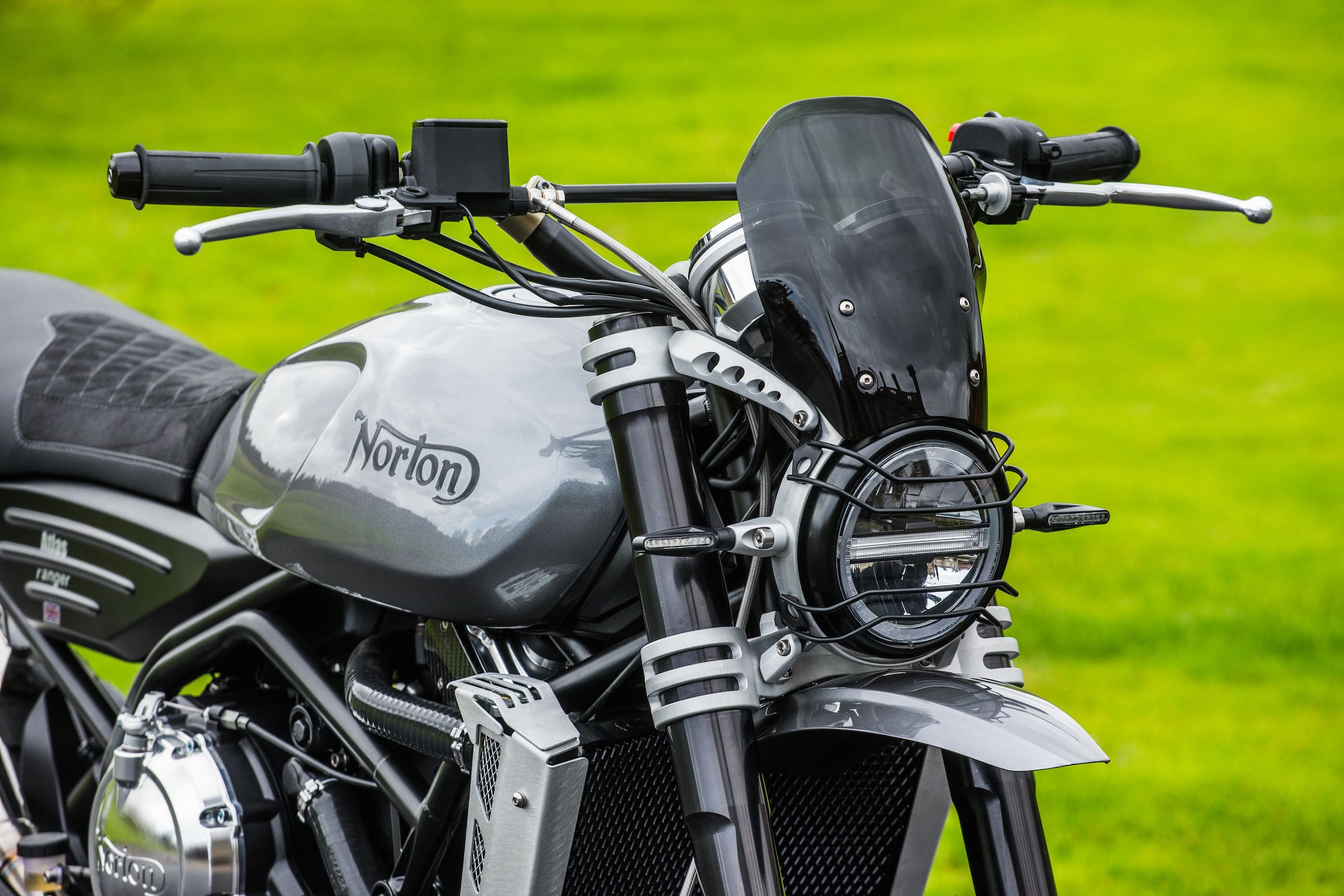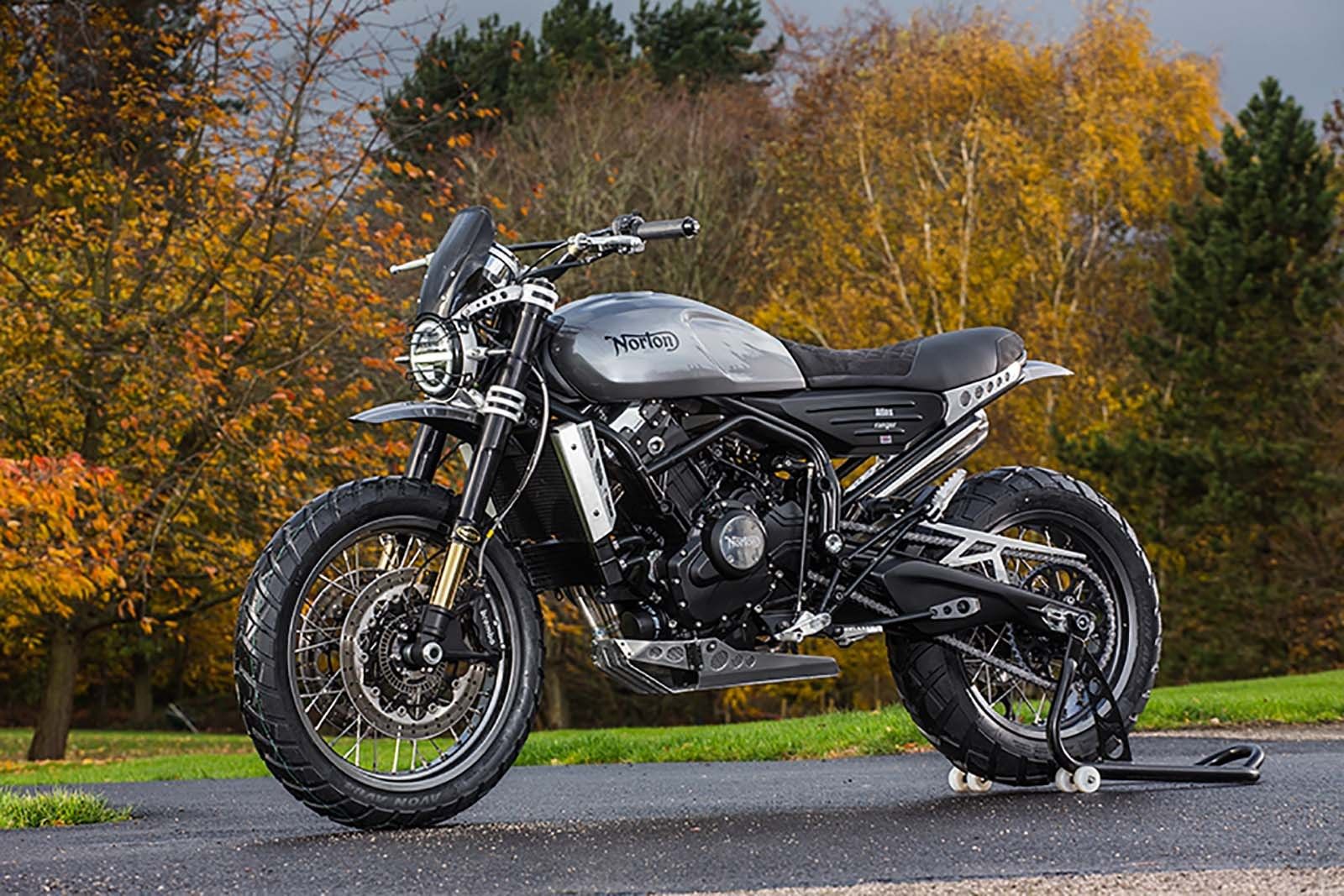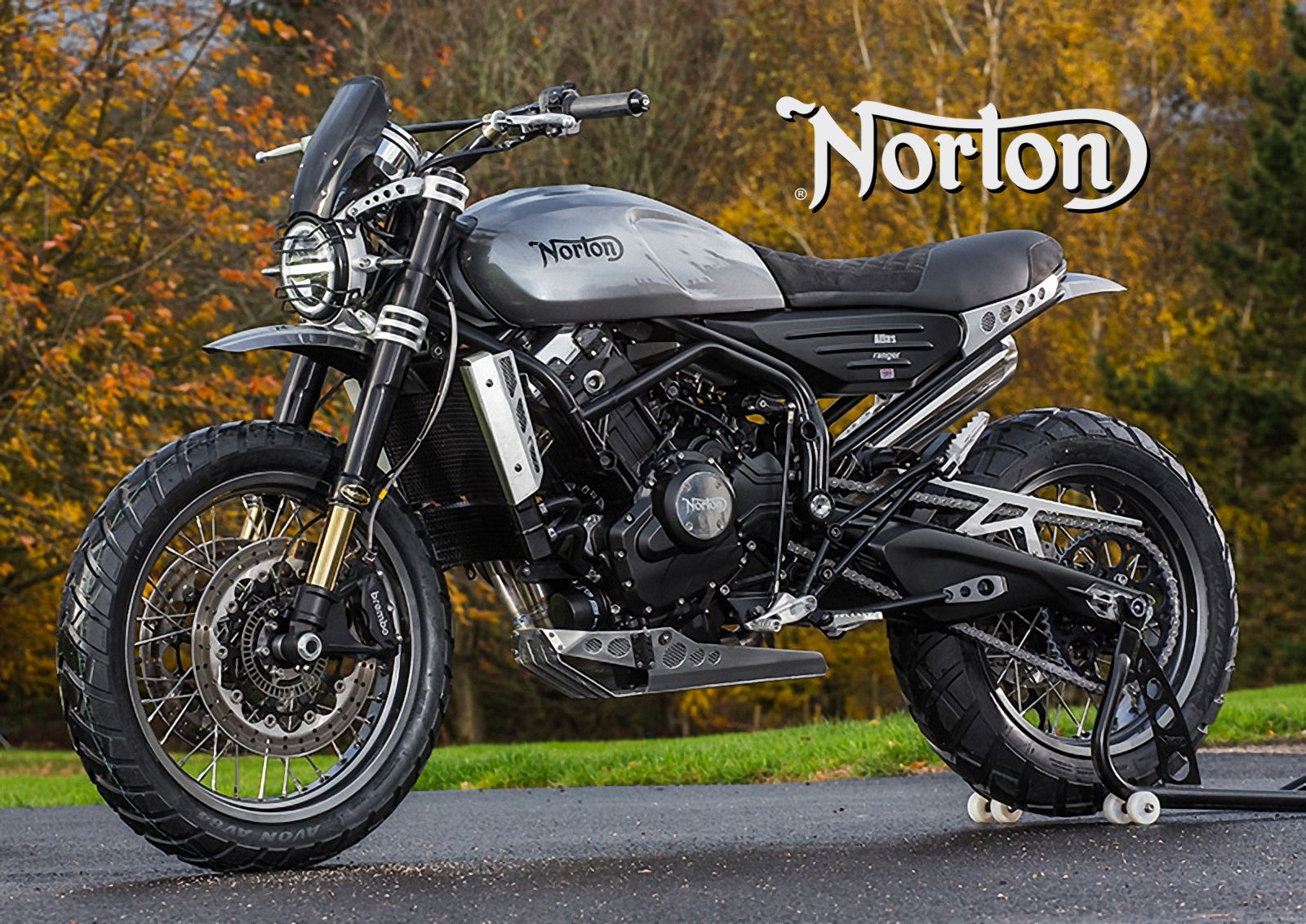Norton Motorcycles' scrambler-esque Atlas line is a great platform for customization, and the factory-custom Ranger is a perfect example of what you can build with the right sort of components. True to its name, the Ranger is set up as a dual-surface machine with a bias for off-road work complete with long-stroke suspension components and wire wheels, and it all comes wrapped around an all-new, mid-size, parallel-twin engine designed and built in-house. Released last year in Europe as an all-new model, Norton brings the Atlas Ranger across the pond for the 2019 model year in the U.S. market.
2019 Norton Atlas Ranger
- Make: Array
- Model: 2019 Norton Atlas Ranger
- Engine/Motor: Parallel-Twin
- [do not use] Vehicle Model: Array
2019 Norton Atlas Ranger Design
Norton's Atlas serves as the core platform for the Ranger and its streetwise sibling, the Nomad. In a nutshell, it's meant to emulate the British standard-cruiser models of the '60s, and the Ranger is typical of the homegrown scramblers of the day. Most of that impression comes from the wire wheels, dirtbike-style front fender, and well-ventilated bash plate. The wire cage over the headlight, flyscreen, and kicked-up exhaust pipe with its generous heat shield finish out the look quite nicely.
A low-rise bar and jockey-mount footpegs combine with the bench seat to give you plenty of room for lateral body English, and since the pillion is on a plane with the pilot, fore-and-aft weight shifts are definitely in the toolbox, as well. Flip-out footpegs complete the passenger's gear, but if I'm honest, I think this bike falls in the “I'd rather not” column as far as sharing the fun with a friend is concerned.
The flyline adopts a slight rise as it moves forward over the teardrop fuel tank to introduce a graceful curvature to the upper lines, and the tank displays the classic knee-pocket look without forming much of an actual pocket at all, but that's okay 'cause it still has the desired effect on the overall look.
Lightening holes and slits are present throughout the design in another nod to the performance efforts of the homespun mechanics from back in the day. The rock guard and smoked flyscreen add to the homebrew charm and add their elements of off-roadiness to the mix, and as much as I like the chopped-down look of the tripletree-mount fender, I question its effectiveness in muddy/nasty conditions. Oh well, if you're out traipsing the wilderness, you have no reasonable expectation of remaining clean/dry, right?
The radiator is relatively inconspicuous, and although it'll never pass as an old-fashioned air-cooled mill, at least it doesn't completely wreck the aesthetic. If you're too young to remember; this is what the early homejob scrambler/enduro/dual-sports looked like; all except for goodies such as the all 'round LED lighting complete with DRLs, of course.
2019 Norton Atlas Ranger Chassis
Seamless steel tubing on the Atlas Ranger makes up a perimeter frame for minimal structure with maximal “internal” space to accommodate the parallel-twin engine, and aluminum swingarm mounts articulate the cast-aluminum, yoke-style rear fork to complete the standing rigging. A coil-over, Roadholder monoshock supports the rear end, and in front, Roadmaster makes another showing with USD forks.
Blacked-out upper struts house gold-colored, 50 mm tubes, and they deliver the full trinity of adjustments. In the rear, the piggyback shock comes with the obligatory variable-preload feature. Both ends have 7.87 inches (200 mm) of travel to absorb some relatively rough terrain, and that's pretty good for a bike that's also meant to safely tackle paved roads.
The wheels are really the best of both worlds with a laced construction that uses aluminum rims, so you get reduced unsprung weight with the performance off-road. Avon's Trekrider series hoops line the rims with a 120/70-19 up front, opposite a 170/60-17, and they are bona fide stealth knobbies with generous street flats and deep grooves that perform well on soft surfaces. Dual Brembo monobloc calipers bite 320 mm front discs, and a third Brembo anchor grabs a 245 mm disc in the rear with ABS protection all around.
|
Frame: |
Twin tube seamless steel perimeter chassis with aluminum swingarm mount. |
|
Swingarm: |
Braced twin spar cast aluminum. |
|
Front Suspension: |
50 mm diameter Roadholder USD forks. Preload, compression and rebound adjustable. |
|
Rear Suspension: |
Roadholder monoshock with rising rate linkage and piggyback reservoir. Adjustable preload. |
|
Wheel Travel, Front/Rear: |
7.9 inches (200 mm)/7.9 inches (200 mm) |
|
Front Brake: |
Dual 320 mm full floating Brembo discs. Radially mounted twin Brembo monoblock calipers with ABS. Brembo master cylinder. |
|
Rear Brake: |
Single 245 mm Brembo disc. Brembo twin piston rear caliper with ABS. Brembo master cylinder. |
|
Front Wheel: |
19 inch spoke wheel with Titanium-colored aluminum rim and 120/70 R19 Avon Trekrider tire. |
|
Rear Wheel: |
17 inch spoke wheel with Titanium-colored aluminum rim and 170/60 R17 Avon Trekrider tire. |
2019 Norton Atlas Ranger Drivetrain
A ride-by-wire throttle control on the Atlas Ranger makes the connection between your wrist and the machine. Together, the throttle bodies carry a total of four injectors to feed the twin cylinders. In spite of the modern throttle control, the rest of the electronics suite is rather sparse, and I mean it. There's no traction control or rider modes, just the essentials, and I guess there is still something to be said for a full-raw ride, even if it does have ABS.
As far as the mechanicals of the thing, it's a parallel-twin with a 270-degree firing order that gives the idle a nice lope, not entirely unlike that of a V-twin. The 650 cc mill runs with an 82 mm bore and 61.5 mm stroke that gives it an 11.5-to-1 compression ratio to put you at the premium hook (or running additives like I do), but that's the trade off for the power it puts out.
The actual figures measure in with 84 horsepower at a lofty 11,000 rpm, backed up by 47 pound-feet of torque to push 392 pounds, dry. Up top, dual over-head cams time the four-valve heads – features borrowed from the V4 engine I might add – to cap the side-by-side bores. True to its superbike origins, this is a rev-loving powerplant that likes to stay near the top of the tachometer range.
|
Engine: |
Norton Designed Liquid-cooled 650 cc parallel twin. 270 degree firing order. Chain driven double overhead cams with idler gear. |
|
Displacement: |
650 cc |
|
Bore x Stroke: |
82 mm x 61.5 mm |
|
Compression Ratio: |
11.5:1 |
|
Power: |
84 hp @ 11,000 rpm |
|
Torque: |
47 lb-ft (64 Nm) |
|
Euro 4: |
Full compliance including secondary air injection and EVAP. |
|
Fuel Injection: |
Electronic fuel injection system. 4 fuel injectors. Full drive-by-wire system. |
2019 Norton Atlas Ranger Pricing
The U.S. is probably falling in around $15k. Unless something changed with the models destined for our shores, you can expect to find it in black, dark grey, silver, red or white finishes.
|
Lighting: |
Full LED lighting system including super bright high and low beam, daytime running lights, rear lamp and indicators. |
|
Colors: |
Black, Dark Grey, Silver, Red, White |
|
Price: |
~$15k |
2019 Norton Atlas Ranger Competitors
It seemed fair to get one Brit to compete against another, so I went straight to Triumph and its new Street Scrambler for my head-to-head with the Atlas Ranger. Trumpet hits most of the same high notes with laced wheels, knee pockets and pads along with a bash plate to complete the ensemble. At the end of the day, Norton makes the more-modern machine, and Triumph has the best historical chops, so it depends on what you like. For me, I like the classic Triumph looks, not gonna' lie.
Norton pulls ahead in the suspension against the Street Scrambler's vanilla setup that comes with a rear preload adjustment only, though the brakes are a wash with Brembo and Nissin equipment on the front and rear of the Triumph, respectively, and ABS protection all around.
As for power, the Street Scrambler also runs a liquid-cooled, parallel-twin plant with an 8-valve head, but the 900 cc mill puts out 64.1 horsepower and 59 pound-feet of torque against the 84/47 Norton, so that displacement advantage does not equate to a power advantage. Triumph does, however, see fit to include variable throttle maps, riding modes and traction control to leave Norton's electronics in the dust. Triumph gets a final shot in with its $11,000 starting price that's way below Norton's sticker.
does0}
“Well, what can I say? It looks the part. Only the inverted forks and water-cooled engine set it apart from any of a number of original scramblers. It's alright as far as it goes, but I'm afraid the inverse relationship between price and electronic refinements may doom the Ranger in any market where it comes up against a Trumpet.”
He Said
My wife and fellow motorcycle writer, Allyn Hinton, says, “The Ranger has nice suspension at its price point when you compare it to the Triumph. The engine is derived from Norton's superbike engine so I expect it to perform well. It's a nice-looking bike but it seems a bit high-revving for any appreciable off-road work.”
She Said
|
Engine & Drivetrain: |
|
|
Engine: |
Norton Designed Liquid-cooled 650 cc parallel twin. 270 degree firing order. Chain driven double overhead cams with idler gear. |
|
Displacement: |
650 cc |
|
Bore x Stroke: |
82 mm x 61.5 mm |
|
Compression Ratio: |
11.5:1 |
|
Power: |
84 hp @ 11,000 rpm |
|
Torque: |
47 lb-ft (64 Nm) |
|
Euro 4: |
Full compliance including secondary air injection and EVAP. |
|
Fuel Injection: |
Electronic fuel injection system. 4 fuel injectors. Full drive-by-wire system. |
|
Chassis: |
|
|
Frame: |
Twin tube seamless steel perimeter chassis with aluminum swingarm mount. |
|
Swingarm: |
Braced twin spar cast aluminum. |
|
Front Suspension: |
50 mm diameter Roadholder USD forks. Preload, compression and rebound adjustable. |
|
Rear Suspension: |
Roadholder monoshock with rising rate linkage and piggyback reservoir. Adjustable preload. |
|
Wheel Travel, Front/Rear: |
7.9 inches (200 mm)/7.9 inches (200 mm) |
|
Front Brake: |
Dual 320 mm full floating Brembo discs. Radially mounted twin Brembo monoblock calipers with ABS. Brembo master cylinder. |
|
Rear Brake: |
Single 245 mm Brembo disc. Brembo twin piston rear caliper with ABS. Brembo master cylinder. |
|
Front Wheel: |
19 inch spoke wheel with Titanium-colored aluminum rim and 120/70 R19 Avon Trekrider tire. |
|
Rear Wheel: |
17 inch spoke wheel with Titanium-colored aluminum rim and 170/60 R17 Avon Trekrider tire. |
|
Dimensions & Capacities: |
|
|
Wheelbase: |
57.9 in (1,470 mm) |
|
Dry Weight: |
392 lbs (178 kg) |
|
Details: |
|
|
Lighting: |
Full LED lighting system including super bright high and low beam, daytime running lights, rear lamp and indicators. |
|
Colors: |
Black, Dark Grey, Silver, Red, White |
|
Price: |
~$15k |
Further Reading
Triumph Bonneville Street Scrambler
See our review of the Triumph Bonneville Street Scrambler.
Norton Atlas Nomad
Review Pending
Norton
Read more Norton news.














